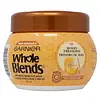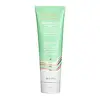What's inside
What's inside
 Key Ingredients
Key Ingredients

 Benefits
Benefits

 Concerns
Concerns

 Ingredients Side-by-side
Ingredients Side-by-side

Water
Skin ConditioningSodium Laureth Sulfate
CleansingSodium Lauryl Sulfate
CleansingCocamide Mea
EmulsifyingGlycol Distearate
EmollientSodium Chloride
MaskingMel
EmollientPPG-5-Ceteth-20
EmulsifyingArgania Spinosa Kernel Oil
EmollientFumaric Acid
BufferingRoyal Jelly
Carbomer
Emulsion StabilisingGlycerin
HumectantDimethicone
EmollientAloe Barbadensis Leaf Juice
Skin ConditioningSodium Hydroxide
BufferingAlcohol
AntimicrobialPropolis Extract
Skin ConditioningGuar Hydroxypropyltrimonium Chloride
Skin ConditioningCitric Acid
BufferingSodium Benzoate
MaskingSalicylic Acid
MaskingCI 19140
Cosmetic ColorantCaramel
Cosmetic ColorantParfum
MaskingCoumarin
PerfumingLimonene
PerfumingBenzyl Alcohol
PerfumingBenzyl Salicylate
PerfumingWater, Sodium Laureth Sulfate, Sodium Lauryl Sulfate, Cocamide Mea, Glycol Distearate, Sodium Chloride, Mel, PPG-5-Ceteth-20, Argania Spinosa Kernel Oil, Fumaric Acid, Royal Jelly, Carbomer, Glycerin, Dimethicone, Aloe Barbadensis Leaf Juice, Sodium Hydroxide, Alcohol, Propolis Extract, Guar Hydroxypropyltrimonium Chloride, Citric Acid, Sodium Benzoate, Salicylic Acid, CI 19140, Caramel, Parfum, Coumarin, Limonene, Benzyl Alcohol, Benzyl Salicylate
Water
Skin ConditioningCetrimonium Chloride
AntimicrobialCetyl Alcohol
EmollientSorbitol
HumectantPanthenol
Skin ConditioningCaprylic/Capric Triglyceride
MaskingHydrolyzed Soy Protein
HumectantStearyl Alcohol
EmollientHelianthus Annuus Seed Oil
EmollientSimmondsia Chinensis Seed Oil
EmollientRosmarinus Officinalis Leaf Extract
AntimicrobialSalix Alba Bark Extract
AstringentTocopherol
AntioxidantRosmarinus Officinalis Leaf Oil
MaskingTilia Cordata Flower Extract
Skin ConditioningGlycerin
HumectantSambucus Nigra Fruit Extract
AstringentVitis Vinifera Seed Extract
AntimicrobialMelilotus Officinalis Extract
AstringentMenthol
MaskingSpirulina Maxima Extract
SmoothingMentha Piperita Oil
MaskingStearamidopropyl Dimethylamine
EmulsifyingPolysorbate 60
EmulsifyingBehentrimonium Methosulfate
Cetearyl Alcohol
EmollientLecithin
EmollientPotassium Sorbate
PreservativeSodium Benzoate
MaskingEthylhexylglycerin
Skin ConditioningParfum
MaskingWater, Cetrimonium Chloride, Cetyl Alcohol, Sorbitol, Panthenol, Caprylic/Capric Triglyceride, Hydrolyzed Soy Protein, Stearyl Alcohol, Helianthus Annuus Seed Oil, Simmondsia Chinensis Seed Oil, Rosmarinus Officinalis Leaf Extract, Salix Alba Bark Extract, Tocopherol, Rosmarinus Officinalis Leaf Oil, Tilia Cordata Flower Extract, Glycerin, Sambucus Nigra Fruit Extract, Vitis Vinifera Seed Extract, Melilotus Officinalis Extract, Menthol, Spirulina Maxima Extract, Mentha Piperita Oil, Stearamidopropyl Dimethylamine, Polysorbate 60, Behentrimonium Methosulfate, Cetearyl Alcohol, Lecithin, Potassium Sorbate, Sodium Benzoate, Ethylhexylglycerin, Parfum
Ingredients Explained
These ingredients are found in both products.
Ingredients higher up in an ingredient list are typically present in a larger amount.
Glycerin is already naturally found in your skin. It helps moisturize and protect your skin.
A study from 2016 found glycerin to be more effective as a humectant than AHAs and hyaluronic acid.
As a humectant, it helps the skin stay hydrated by pulling moisture to your skin. The low molecular weight of glycerin allows it to pull moisture into the deeper layers of your skin.
Hydrated skin improves your skin barrier; Your skin barrier helps protect against irritants and bacteria.
Glycerin has also been found to have antimicrobial and antiviral properties. Due to these properties, glycerin is often used in wound and burn treatments.
In cosmetics, glycerin is usually derived from plants such as soybean or palm. However, it can also be sourced from animals, such as tallow or animal fat.
This ingredient is organic, colorless, odorless, and non-toxic.
Glycerin is the name for this ingredient in American English. British English uses Glycerol/Glycerine.
Learn more about GlycerinParfum is a catch-all term for an ingredient or more that is used to give a scent to products.
Also called "fragrance", this ingredient can be a blend of hundreds of chemicals or plant oils. This means every product with "fragrance" or "parfum" in the ingredients list is a different mixture.
For instance, Habanolide is a proprietary trade name for a specific aroma chemical. When used as a fragrance ingredient in cosmetics, most aroma chemicals fall under the broad labeling category of “FRAGRANCE” or “PARFUM” according to EU and US regulations.
The term 'parfum' or 'fragrance' is not regulated in many countries. In many cases, it is up to the brand to define this term.
For instance, many brands choose to label themselves as "fragrance-free" because they are not using synthetic fragrances. However, their products may still contain ingredients such as essential oils that are considered a fragrance by INCI standards.
One example is Calendula flower extract. Calendula is an essential oil that still imparts a scent or 'fragrance'.
Depending on the blend, the ingredients in the mixture can cause allergies and sensitivities on the skin. Some ingredients that are known EU allergens include linalool and citronellol.
Parfum can also be used to mask or cover an unpleasant scent.
The bottom line is: not all fragrances/parfum/ingredients are created equally. If you are worried about fragrances, we recommend taking a closer look at an ingredient. And of course, we always recommend speaking with a professional.
Learn more about ParfumSodium Benzoate is a preservative. It's used in both cosmetic and food products to inhibit the growth of mold and bacteria. It is typically produced synthetically.
Both the US FDA and EU Health Committee have approved the use of sodium benzoate. In the US, levels of 0.1% (of the total product) are allowed.
Sodium benzoate works as a preservative by inhibiting the growth of bacteria inside of cells. It prevents the cell from fermenting a type of sugar using an enzyme called phosphofructokinase.
It is the salt of benzoic acid. Foods containing sodium benzoate include soda, salad dressings, condiments, fruit juices, wines, and snack foods.
Studies for using ascorbic acid and sodium benzoate in cosmetics are lacking, especially in skincare routines with multiple steps.
We always recommend speaking with a professional, such as a dermatologist, if you have any concerns.
Learn more about Sodium BenzoateWater. It's the most common cosmetic ingredient of all. You'll usually see it at the top of ingredient lists, meaning that it makes up the largest part of the product.
So why is it so popular? Water most often acts as a solvent - this means that it helps dissolve other ingredients into the formulation.
You'll also recognize water as that liquid we all need to stay alive. If you see this, drink a glass of water. Stay hydrated!
Learn more about Water